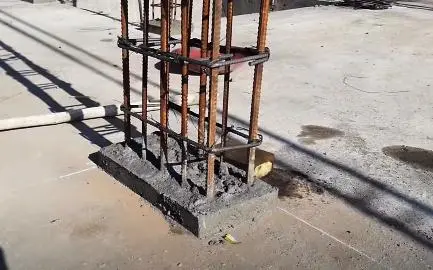Table of Contents
Column Kicker may be defined as a small concrete step utilized at the base of columns or walls to ensure that the proper coordinates of columns or walls are retained between floor slabs. So, a column kicker should be utilized at all places where columns or walls are completed.
A column kicker is also named a column starter.
This 5 cm-15 cm step is constructed at the base of a column or wall during the pouring of a concrete slab. The width and length of a column kicker are the exact as the column for which it’s being built.
Columns are defined as long slender member load axially in compression and having lateral dimensions very small as compared to their lengths.
A vertical compression member is called a column. If load passes through the longitudinal axis coinciding with the CG of the column, it is called the axially loaded column, otherwise eccentrically loaded column.
Columns are the building structures connected to different footings to transfer the load of the building to the footings of the buildings.
To reduce column size on the construction site you need to follow three guidelines that are as follows:
1) You should provide a higher grade of concrete with higher compressive strength.
2) You should provide higher-grade Steel
3) You should provide composite column cross-sections (enclosed or infilled), that have a good architectural appearance and fit into available space.

1. Uses of Column Kicker
The uses of column kicker are as follows:
✔ It is used to maintain proper coordinates of columns or walls.
✔ It is used to improve the construction quality.
✔ It is used to solve the issues related to leveling.
2. Dimensions and Formwork of Column Starter
The thickness of the column kicker varies from 50mm to 150mm whereas its width and length are the exact as the column for which the kicker is made. The suitable height of the column kicker is about 150mm because it delivers a satisfactory structural start for the column or wall.
Structurally, the thickness of the kicker is smaller than 150mm is not preferred. If the kicker thickness is more than 150mm, then it manages to slump with the weight of concrete in them. After the formwork of the column kicker is positioned, then fresh concrete is set monolithically with the slab.
3. Way To Make Column Kicker
The way to prepare column kicker are as follows:
a. Stack rocks around the side and bottom to form a strong base to build on.
b. Add dirt.
c. Pack the lip firm, making sure you allow space for the concrete on top.
d. Put chicken wire frame between concrete and dirt.
e. Add concrete to the lip.
3. Advantages of Column Kicker
There are various advantages that come with the utilization of a column kicker, that is as follows:
✔ Capable to resolve any problems with leveling more efficiently.
✔ Capability to support wall proportions between slabs
✔ Controlling motion of columns
✔ Maintaining the vertical alignment of columns Simplifying the installation of column formworks
✔ Increases construction quality (if accomplished correctly)
✔ A decrease in the number of joints in the concrete.
✔ It makes sure the requirement of designated column concrete cover.
4. Disadvantages of Column Kicker
The disadvantages of column kicker are as follows:
✔ There is a risk of cracks in the column.
✔ Likely formation of joints at the bottom of columns or walls.
| Read Also: Floating Column |

